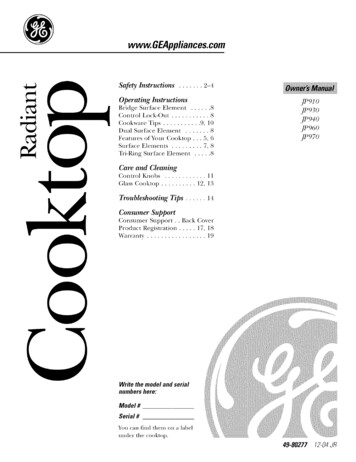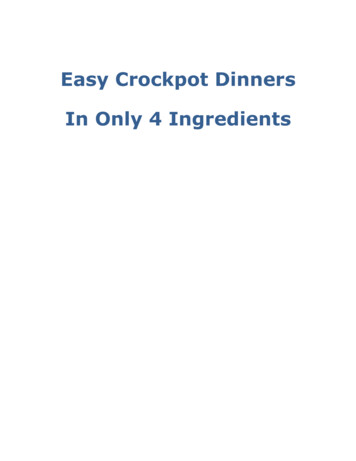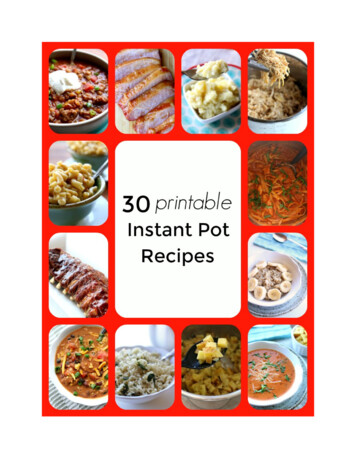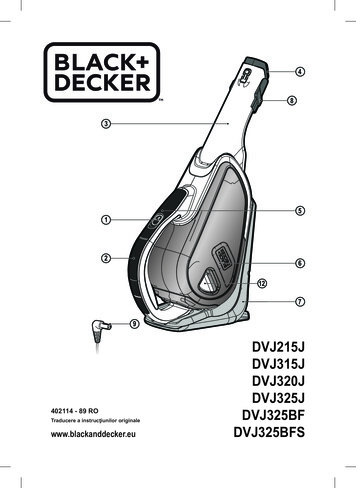
Transcription
ThePot BookA Complete Guideto CannabisIts Role in Medicine, Politics,Science, and CultureEdited by Julie Holland, M.D.Park Street PressRochester, Vermont Toronto, CanadaPotBoo.indd 38/16/10 9:35:20 AM
ContentsForeword by Lester Grinspoon, M.D.xiIntroduction1Pa r t O n eAn Overview of Cannabis1Introduction to Part One6The Subjective Effects of Cannabis9Matthew G. Kirkpatrick and Carl L. Hart, Ph.D.2Early/Ancient History17Chris Bennett3Recent History27David Malmo-Levine4The Botany of Cannabis35Lyle E. Craker, Ph.D., and Zoë Gardner5Cannabis Grow Revolution44Danny Danko6The Endocannabinoid System52Gregory L. Gerdeman, Ph.D., andJason B. Schechter, Ph.D.7Anandamide and More63Raphael Mechoulam, Ph.D., and Lumír Hanuš8Cannabis Laws in the United States73Allen St. Pierre9On Ending Prohibition130Ethan Nadelmann, J.D., Ph.D.PotBoo.indd 78/16/10 9:35:23 AM
Pa r t T w oRisks of Use and Harm Reduction10Introduction to Part Two136Medical Risks and Toxicology141William Holubek, M.D.11Pulmonary Harm and Vaporizers153Mitch Earleywine, Ph.D.12Cannabis and Cognition161Caroline B. Marvin and Carl L. Hart, Ph.D.13Mental Health Risks Associated with Cannabis Use178Cheryl Corcoran, M.D.14How Real Is the Risk of Addiction?187Ryan Vandrey, Ph.D., and Margaret Haney, Ph.D.15Driving Under the Influence196Paul Armentano16Arrest Statistics and Racism202Harry G. Levine, Ph.D.17Getting Busted Is Not So FunnyAn Interview with Tommy Chong207Julie Holland, M.D.18The Collateral Consequences of Cannabis Convictions 219Richard Glen Boire, J.D.19Harm Reduction Psychotherapy223Andrew Tatarsky, Ph.D.Pa r t T h r e eThe Clinical Use of Cannabis20Introduction to Part Three242The Clinical Applications of Medical MarijuanaAn Interview with Andrew Weil, M.D.247Julie Holland, M.D.PotBoo.indd 88/16/10 9:35:24 AM
21Medical Marijuana ResearchAn Interview with Donald Abrams, M.D.252Julie Holland, M.D.22MAPS and the Federal Obstruction ofMedical Marijuana Research261Rick Doblin, Ph.D.23The Government’s Pot FarmAn Interview with Mahmoud A. ElSohly, Ph.D.266Julie Holland, M.D.24Cannabinoids and Psychiatry282Julie Holland, M.D.25Cannabinoids and Neuroprotection295Sunil K. Aggarwal, M.D., Ph.D., andGregory T. Carter, M.D.26Cannabis and HIV/AIDS311Mark A. Ware, M.D., and Lynne Belle-Isle27Multiple Sclerosis and Spasticity318Denis J. Petro, M.D.28Pain Management328Mark S. Wallace, M.D., and Ben Platt, M.D.29Sativex336William Notcutt, M.D., F.R.C.A., F.F.P.M.R.C.A.Pa r t F o u rCannabis CultureIntroduction to Part Four34430What to Tell the Children349Marsha Rosenbaum, Ph.D.31Pot, Parenting, and Outing Myself361Neal Pollack32Cannabis: Stealth Goddess366Doug RushkoffPotBoo.indd 98/16/10 9:35:26 AM
33Gardener’s Rights, Forgetting, and Co-EvolutionAn Interview with Michael Pollan373Julie Holland, M.D.34Cannabis, Business, and PhilanthropyAn Interview with Peter Lewis383Julie Holland, M.D.35Thots on Pot387Jeremy WolffPa r t F i v eSteps in the Right Direction36Introduction to Part Five396Patients Out of TimeAn Interview with Al Byrne, L.CDR. (retired), andMary Lynn Mathre, R.N., C.A.R.N.399Julie Holland, M.D.37Prescribing Cannabis in California416Jeffrey Hergenrather, M.D.38Canadian Compassion Clubs432N. Rielle Capler, M.H.A.39Dutch Drug Policy441Mario Lap40A Cost-Benefit Analysis of Legalizing Marijuana447Jeffrey Miron, Ph.D.41The Marijuana Policy Project454Bruce Mirken42The ACLU and Cannabis Drug Policy462An Interview with Graham Boyd, J.D.Julie Holland, 44PotBoo.indd 108/16/10 9:35:26 AM
IntroductionI didn’t start out editing this book as an expert on cannabis. I felt morecomfortable editing my last book, on MDMA (Ecstasy), because I had beenstudying its potential use in psychiatry for fifteen years prior to its publication. This time, I knew very little going in. And so, feeling a bit over myhead, I amassed a group of experts on cannabis to help explain what I couldnot. Both books are nonprofit ventures; proceeds from sales of the bookswill fund clinical research on their respective drugs. Please see ThePotBook.com to learn more as well as to find other articles on cannabis.I am editing this book for many of the same reasons that inspired mylast book. Cannabis, like MDMA, is considered both a drug and a medicine. Both drugs are widely used recreationally but also have therapeuticpotential.As most people know, the status of medical cannabis at the federal levelis different from its status at the state level. With the introduction of theControlled Substances Act of 1970, marijuana was classified as a Schedule Idrug, the strictest classification, on par with heroin, LSD, and Ecstasy; andas such, it was outlawed. However, cannabis is deemed a prescription medication in nearly a third of the United States, where it is recommended for thetreatment of nausea, pain, diminished appetite, muscle spasms, insomnia . . .the list goes on. Fourteen states and the District of Columbia have legalizedmedical marijuana: Alaska, California, Colorado, Hawaii, Maine, Michigan,Montana, Nevada, New Jersey, New Mexico, Oregon, Rhode Island, Vermont,Washington, and Washington, D.C. In Maryland, if it can be proven thatcannabis is a medical necessity, reduced penalties apply. California, Colorado,New Mexico, Maine, Rhode Island, and Montana are currently the onlystates to utilize dispensaries to sell medical cannabis.With regard to drug use around the globe, when nations are compared,the World Health Organization finds clear differences across different1PotBoo.indd 18/16/10 9:35:28 AM
2 I n t r o d u c t i o nregions of the world, with the United States having among the highest levelsof legal and illegal drug use of all the countries surveyed. Drug use does notappear to be related to drug policy, however, as countries with more stringentpolicies (e.g., the United States) do not have lower levels of illegal drug usethan countries with more liberal policies (e.g., the Netherlands) (Degenhardtet al. 1988).It’s important to look at these numbers. Forty-three percent of Americanshave tried pot, as opposed to 20 percent of the Dutch, despite their morelenient policies (MacCoun and Reuter 2001). (In Holland, possession andproduction for personal use are considered misdemeanors, punishable by afine only.) Also, interestingly, after California opened up its medical marijuana program, teen cannabis use fell (MPP 2008), proving that making adrug more available in a specific framework does not necessarily yield rampant abuse of that drug.Cannabis is the most popular illicit drug in the world. An estimated 162million adults worldwide, 52 million in Asia, and somewhere between 11 and20 million Americans are regular users (United Nations 2006). Accordingto the most recent available data, 3.5 million U.S. citizens report smokingmarijuana daily or near-daily, 14.5 million report smoking the drug at leastonce a month, and more than 100 million have tried it at least once in theirlives (Substance Abuse and Mental Health Services Administration 2008).That’s nearly 43 percent of the American population aged twelve years andolder admitting to the federal government about their illegal drug use. Thenumbers are most likely much higher.Because millions of people around the world are using cannabis, thesensible course of action is to find ways to minimize its harmful impact.Most useful medications have recommended doses and toxic doses, as well asmethods of ingestion that minimize harm and maximize therapeutic results.Harm-reduction strategies should include not only utilizing vaporizers todiminish pulmonary disease, but also a careful reexamination of our druglaws. It is illogical that the most harmful consequence of cannabis use isa blow delivered by our legal system. There’s a great Jimmy Carter quote Ilove: “Penalties against possession of a drug should not be more damaging toan individual than the use of the drug itself.”Yet somehow we persist in punishing the pot smokers, adding them tothe heap of imprisoned Americans. Our nation now leads every other country on the planet in one thing: more prisoners. One percent of Americanadults are in jail. Both per capita and in absolute terms, we put more of ourPotBoo.indd 28/16/10 9:35:28 AM
I n t ro d u c t i o n 3own nation in prisons than any other. In 2009, half of all federal prisoners in the United States were serving sentences for drug offenses (Mendoza2010). U.S. spending on the drug war tops 100 billion annually. Each prisoner costs 45,000 per year. That is very expensive public housing.As long as cannabis is illegal, there will be a black market for its sale anddistribution. And underground means unregulated. Despite intensive eradication efforts, domestic marijuana production has increased tenfold over thepast twenty-five years, from 2.2 million pounds in 1981 to 22 million poundsin 2006. American gang members are the primary retail distributors of mostillegal drugs, and they have increased their ranks to nearly 1 million, growing20 percent from 2005 to 2008, according to the Justice Department (2009),which reports that gangs are responsible for up to 80 percent of the crime inmany communities. Mexican drug cartels make 70 percent of their profitsfrom marijuana sales. There is no question in anyone’s mind that the Mexicangangs and the warfare that is waged on both sides of our borders is primarilymarijuana-driven. Legalize cannabis, and this mess most likely goes away.The other important issue here is children’s access to pot. All surveys ofteenagers show that it is getting easier for them to acquire marijuana as timegoes on; teens have an easier time buying it than purchasing cigarettes oralcohol. Dealers don’t card. Liquor stores do. Also, dealers may interest kidsin purchasing other drugs besides marijuana. What the Netherlands figuredout a long time ago is that if you separate cannabis from the harder drugs,you can have an impact on which drugs teenagers end up using. In Holland,they have one quarter as many cocaine users as we have in America. Lessthan 2 percent of the adult population has ever used cocaine. Lifetime cannabis use in the Dutch population aged twelve years and over is less than halfof what it is in America (Degenhardt et al. 2008). (For more on the Dutch,please see chapter 39.) It is quite possible that a harm-reduction-based drugpolicy could keep our country healthier.What I hope to outline in the pages that follow is a comprehensive assessment of cannabis, its risks and benefits, including the ramifications of ourcurrent drug policy. I have gathered experts from around the world to cometogether and teach what I could not, to share their knowledge with you all. Ihope you learn as much as I learned in the process of editing this book.PotBoo.indd 38/16/10 9:35:28 AM
24Cannabinoids andPsychiatryJulie Holland, M.D.The study of cannabis and cannabinoids could be enormously beneficial tothe field of psychiatry. Cannabis has been used as a treatment for depression,anxiety, inattention, malaise, and insomnia for thousands of years. Millionsof people around the world are using marijuana to “self-medicate” thesesymptoms and others. For these two reasons alone, it would behoove us tohave a better understanding of the medicinal properties of this plant.Specific to the field of psychiatry, we have much to learn about thebrain’s endogenous cannabinoid system. To study THC, CBD, and othercannabinoids is to better understand ourselves, our brain chemistry, thebrain’s response to injury, and the underlying pharmacology of mind statessuch as paranoia and panic. Understanding the chemistry and physiology ofthe cannabinoid molecules could potentially help us create analogues andantagonists to treat other symptoms and diseases. (For example, the cannabinoid antagonist rimonabant can help curb appetite, or stop the “munchies,”but, interestingly, it was rejected by the FDA due to concerns surrounding itsability to induce depression, anxiety, and suicidal thoughts.)In my private practice, I see and treat many pot smokers. Some of themnote that smoking marijuana helps them fall asleep or relax, and they tendto smoke at the end of their day. Others find it helps them focus, be creative, or become more meticulous and obsessive; these patients tend to use282PotBoo.indd 2828/16/10 9:36:01 AM
C a n n a b i n o i d s a n d P s yc h i a t r y 2 83marijuana before starting a project. I have patients with attention deficit disorder (ADD) who feel it helps them pay attention to minute details. I alsohear from a fair number of people with depression that it can reliably lifttheir spirits and create a much-longed-for sense of euphoria and hopefulness.Then there are my anxious or panicky patients who feel that pot makes theirsymptoms worse; they become more self-conscious and hyperaware, and theyare not at all comfortable with marijuana’s effects. On the other hand, I havesome anxious patients who swear by it as an aid to relaxation. Any reasonable clinician should be intrigued by this phenomenon: Why are so manypatients having such vastly different effects and experiences?The joke I always make about cannabis with my patients is that it is a“mixed bag.” Because there is such tremendous genetic diversity in cannabis,every strain is unique. Each time someone makes a purchase, they are gettinga different medicine, so to speak. Hybrids abound in New York City as theydo in the rest of the world, and it is nearly impossible to know just what themix will be. If they buy an indica-predominant strain, they may becomesleepier, more relaxed, and possibly less motivated. A sativa-predominantstrain may help energize or focus their thoughts. Both strains seem to induceappetite, which may be a nuisance for some users, but a blessing for thosepatients made nauseated and anorectic by their medications or illnesses.Some strains might trigger paranoia, perhaps due to a high THC content,while another strain might have an opposite effect if it is CBD-heavy (seebelow).Our brains, in particular the cortex where higher thinking and planning are performed, are full of receptors for cannabis. An interconnectednetwork, the cannabinoid system, makes use of our own endogenously madecannabis-like molecules, which are called endocannabinoids. In much thesame way as endorphins stimulate our opioid receptors, our bodies makeanandamide to activate our cannabinoid receptors. Much like the humanrace and the opium poppy, we have been co-evolving on this planet with thecannabis plant since our beginnings. Cannabis was likely one of the firstplants to be domestically cultivated.It has been used as a medicine since the third century BCE, and it hasa long history of being used to treat psychiatric complaints as well as physical ones (please see chapter 2 by Chris Bennett). The Atharva Veda (around2000 BCE) tells of using bhanga to “release us from anxiety” (InternationalHemp Drugs Commission 1893). In ancient Assyrian medical texts, smoking is mentioned as a way to “dispel depression of spirits” (Thompson 1924).PotBoo.indd 2838/16/10 9:36:01 AM
2 8 4 T h e C l i n i c a l U s e of C a n n a b i sPeople of the Dutch East Indies noted that cannabis “serves to drive awaysorrow and bring them jollity” (Rumpf and Beekman 1981). In Burton’sAnatomy of Melancholy, he describes the intoxication of cannabis as a “kindof ecstasy, an inclination gently to laugh.” In England, in the mid-1800s, atincture of hemp was used to treat morphine withdrawal, inducing “sleep; asan anodyne in lulling irritation . . . a nervine stimulant in removing languorand anxiety” (Clendinning 1843).In France, the physician Jacques-Joseph Moreau de Tours first wrote ofcannabis’s potential for treating psychiatric patients in his book Du hachischet de l’alienation mentale: Etudes psychologiques (“Of hashish and insanity:Psychological studies”), noting that hashish produced “manic excitementalways accompanied by a feeling of gaiety and joy inconceivable to those whohave never experienced it. I saw in it a means of effectively combating thefixed ideas of depressives, disrupting the chain of their ideas, un-focusingtheir attention on such and such a subject.” And in America, an Ohio physician, reporting on a case he identified as “hysterical insanity,” wrote of cannabis, “In those mixed and indefinable paroxysms of an hysterical nature,I have found no remedy to control or curtail them with equal promptnessand permanency. . . . In sleeplessness, where opium is contraindicated, it isan excellent substitute. . . . Calmative and hypnotic, in all forms of nervousinquietude and cerebral excitement, it will be found an invaluable agent, asit produces none of those functional derangements or sequelae that rendermany of the more customary remedies objectionable” (McMeens 1860).The English physician John Russel Reynolds, best known as the personalphysician to Queen Victoria, had a long career of using and championingcannabis as medicine. Early reports of success treating depression, lassitude,and senile restlessness (Reynolds 1868) paved the way for forty years of successful practice. About the treatment of senile insomnia, he wrote, “I havefound nothing comparable in utility to a moderate dose of hemp” (Reynolds1890).A British pharmacologist suggested, “In cases where an immediate effectis desired, [cannabis] should be smoked, the fumes being drawn throughwater, for fits of depression, mental fatigue, nervous headache, and exhaustion, a few inhalations produce an almost immediate effect, the sense ofdepression, headache, feelings of fatigue disappear and the subject is enabledto continue his work, feeling refreshed and soothed” (Dixon 1899).Lewis, in 1900, described the effects of cannabis: “The mind seems whollytaken with thoughts of the moment. Very frequently a great inexplicable sensePotBoo.indd 2848/16/10 9:36:01 AM
C a n n a b i n o i d s a n d P s yc h i a t r y 2 85of relief is felt, the sensation being identical with that experienced by one whosuddenly awakes from a horrible dream to the feeling of gratitude which isalways felt at its unreality.” In Southeast Asia, cannabis was used as a tonic inchronic illness, to induce sleep, and as a relaxant. In Vietnam, a preparationof cannabis seeds was used to “combat loss of memory and mental confusion”(Martin 1975).Cannabis was used to treat delirium tremens (withdrawal from alcoholdependence) and addiction to cocaine and opiates. Mattison (1891) concluded,“In these, often, it has proven efficient substitute for the poppy. . . . My experience warrants this statement: cannabis indica is often a safe and successful anodyne and hypnotic.” Cannabis has been used to treat opiate addiction(Mayor’s Committee on Marijuana 1944) and alcoholism (Mikuriya 1970;O’Shaughnessy 2007) with good results. A study of THC in cancer patientsreported positive psychological effects of “a tranquilizer and mild mood elevator, clearly without untoward effects on cognitive functioning and apparentlywithout untoward effect on personality or emotional stability—at least as canbe measured by psychological tests” (Regelson et al. 1976).A survey of California clinicians working with cannabis revealed psychiatric symptoms to be a common indication for a prescription. (Nearlyevery patient coming to these clinicians had already been using cannabis totreat their symptoms, so a more appropriate term for what these physiciansoffer may be “approval,” as opposed to “recommendation.”) From JeffreyHergenrather: “In my opinion, there is no better drug for the treatmentof anxiety disorders . . . ADHD, obsessive compulsive disorder, and PostTraumatic Stress Disorder” (O’Shaughnessy 2007).Doctors responding to the survey reported that many of their patients wereable to decrease their use of other psychiatric medications, like antidepressant,antianxiety, and sleeping medications, or else they used cannabis to treat theirside effects of jitteriness or gastrointestinal problems in order to stay on theirmedications.The Psychoactive Effects of CannabisThe psychoactive effects of cannabis are mediated primarily through theCB1 receptors (Pertwee 1997). (Please see chapter 12 on cognition for areview, as well as chapter 6 on the endocannabinoid system.)The CB1 antagonist rimonabant has been shown to block the subjectiveeffects of marijuana (Huestis et al. 2001) as well as induce depression. It ispostulated that dysregulation of the endocannabinoid system is involved inPotBoo.indd 2858/16/10 9:36:01 AM
2 8 6 T h e C l i n i c a l U s e of C a n n a b i sthe emotional processing of stressful events. In a study with mice, impairedCB1 receptor signaling interfered with stress-coping behavior (Steiner et al.2008). In mice bred to have no CB1 receptors, many abnormalities were seen,taken as a whole to support an “increased susceptibility to develop an anhedonic state” (Martin et al. 2002).As delineated in chapter 12 by Carl Hart, the subjective effects of cannabis depend on dosage, route of administration, and, most crucially, theset (expectations) and setting (environment). Also important is the person’sfamiliarity with cannabis. Many of my patients have told me that they didn’tget “high” the first time they smoked pot. Some theorize that this is becausethey didn’t know what “high” was and couldn’t recognize it when it was uponthem. Others believe there is some sort of priming mechanism involved, theway one would have to prime the pump of a well. Not becoming intoxicatedthe first time one smokes cannabis is a curious, though not universal, phenomenon that deserves more study.Anti-psychotic Effects of CBD:Cannabis and SchizophreniaWhile cannabis has frequently been implicated in causing or exacerbatingpsychosis, there are actually promising leads in using cannabidiol CBD as anantipsychotic medication. (Please see chapter 13 for more on this.) UnlikeTHC, CBD is a noneuphoriant, anti-inflammatory analgesic that does notbind well to the CB1 or CB2 receptors. Zuardi and colleagues (1997) haveproposed that the ratio of THC to CBD is crucial in determining the effectsof cannabis on psychosis, and these two components have been studied extensively. Currently, it is widely believed that cannabis strains that are higher inTHC are more apt to produce paranoia and other symptoms reminiscent ofpsychosis, while those higher in CBD are less likely to do so. This is likelythe problem with the strains known as “skunk,” which have much higherratios of THC to CBD. This may also end up being an issue with “Spice,” asynthetic cannabinoid also known as K2 (made up of certain psychoactivechemicals such as JWH-018, JW-073, JWH-250, HU-210, and a homologueof CP-47, 497, that are, as of this writing, not yet scheduled; please checkThePotBook.com for more on this), which acts as a full, potent agonist atthe CB1 receptor, as opposed to THC, which is a weak partial agonist.While THC is responsible for the euphoric and anxiety-inducing effects ofcannabis, CBD may modulate these effects, causing sedation and diminishinganxiety (Zuardi and Guimaraes 1997). Thus, strains with higher THC/CBDPotBoo.indd 2868/16/10 9:36:01 AM
C a n n a b i n o i d s a n d P s yc h i a t r y 2 8 7ratios may be more paranoia-inducing or anxiety-provoking, than those strainswith higher levels of CBD. More importantly, CBD may actually diminishpsychotic symptoms in patients who have them, such as those with schizophrenia (Zuardi et al. 1995). CBD was also found to reduce psychotic symptoms ina group of patients with Parkinson’s disease (Zuardi et al. 2009).In a 1994 study by Warner, psychotic patients who used marijuana hadlower rates of hospitalization than those who abused other substances. Theywere also found to have lower activation symptoms such as psychomotoragitation. These patients reported beneficial effects on depression, anxiety,insomnia, and pain. In a review of twenty-three studies of schizophrenicsusing cannabis, fourteen studies reported that cannabis users had better cognitive performance than nonusers. Eight reported no difference, and onlyone study reported better cognitive performance in the schizophrenics whodid not use cannabis. The authors say this meta-analysis confirmed theirown experiences with cannabis-using patients (Løberg and Hugdahl 2009).Negative symptoms of schizophrenia (thinking and talking less, havingless motivation and activity) are particularly stubborn symptoms to ameliorate with antipsychotic medications. Bersani and colleagues (2002) noteda subgroup of schizophrenics who used cannabis to decrease their negativesymptoms. On the other hand, Verdoux (2003) noted a significant association between cannabis use and the negative symptoms of schizophrenia. Itis crucial that CBD be carefully studied to determine if it may have a placein psychiatry as an antipsychotic, potentially not only quieting the positivesymptoms of schizophrenia (namely the paranoia and hallucinations), butalso ameliorating the very difficult-to-treat negative symptoms of amotivation, depression or blunted affect, and talking and thinking less.The prefrontal cortex is a particular area of interest in schizophreniaresearch. It is one of the parts of the brain known to be dysfunctional in peoplewith schizophrenia, and many antipsychotics exert some of their beneficial effectthere (Thierry et al. 1978). A high density of CB1 receptors can be found in theprefrontal cortex (Herkenham et al. 1990). The primary neurotransmitter abnormalities in schizophrenia involve dopamine, which interacts with the cannabinoidsystem. THC enhances the flow and utilization of dopamine in the prefrontalcortex (Chen et al. 1990) and, conversely, activation of dopamine receptors (D2)causes an increased outflow of anadamide (Giuffrida et al. 1999).A 2009 study using receptor tracers and PET (positron emissiontomography) scans showed that THC induces dopamine release in thehuman striatum. This implies that the endogenous cannabinoid system isPotBoo.indd 2878/16/10 9:36:01 AM
2 8 8 T h e C l i n i c a l U s e of C a n n a b i sinvolved in regulating striatal dopamine. This is important for two reasons. Not only is there dopamine dysfunction in this area in schizophrenia, but also drugs of abuse are often enhancers of dopamine levels, thuscreating pleasure, excitement, and possibly an increased risk of addictionthrough this “reward pathway” (Bossong et al. 2009).In a clinical case series, four chronic, treatment-refractory schizophrenicpatients (who had reported improvement in their symptoms when theysmoked cannabis) were administered oral THC (dronabinol). Three of thefour showed significant improvement in core psychotic symptoms. Theresults would suggest “that the role of cannabinoids in psychosis may bemore complex than previously thought. They open a possible new role forcannabinoids in the treatment of schizophrenia” (Schwarcz et al. 2009).DepressionAs reviewed above, there is abundant clinical lore, both ancient and recent,that cannabis can help lift one’s mood. In my private practice, it comes upfairly often: my patients use marijuana to feel better. In an Internet surveyof over 4,400 respondents (Denson and Earleywine 2006), those who usecannabis had lower levels of depressive symptoms than those who had nevertried cannabis. Weekly and daily users of cannabis had less depressed moodand more positive affect than nonusers.In an exquisitely complicated review paper (Hill 2005), melancholicdepression was compared to an endogenous cannabinoid deficiency. Further,the author makes an excellent case for using the cannabinoid system as atarget for future antidepressant development. In a follow-up paper, Hill andcolleagues (2008) measured one of the endogenous cannabinoids, 2-AG,in depressed patients. Serum 2-AG content was significantly decreased inpatients diagnosed with major depression, and the 2-AG content was progressively lower the longer the depressive episode.In an overview by Mangieri and Piomelli (2007) of the cannabinoid system and depression, the authors state, “The overlap between the physiologicalfunctions altered by depression and those affected by cannabinoid receptor signaling is striking.” They continue, “changes in levels of the cannabinoid CB1receptor or the endogenous CB1 receptor ligands, anandamide and 2-AG, areobserved both in humans suffering from depression and in animal models ofdepression, and experimental manipulation of CB1 receptor signaling has alsobeen shown to affect emotional reactivity in rodents.” CB1 receptors may beup-regulated in suicide victims suffering from depression, as was shown in aPotBoo.indd 2888/16/10 9:36:02 AM
C a n n a b i n o i d s a n d P s yc h i a t r y 2 8 9study of postmortem brains (Vinod and Hungund 2006). This may suggest ahypofunctioning cannabinoid system in depressed or suicidal patients.Bipolar DisorderIn a short review article (Ashton et al. 2005), several points were laid out.Though there are no placebo-controlled trials of cannabinoids in bipolarillness, there exist many anecdotal reports of patients experiencing relief ofboth the depressed and manic phases of their illness. CB receptors are plentiful in areas of the brain thought to be affected by bipolar illness. Patientsmay experience psychosis or a manic episode due to cannabis use, or theymay be more sensitive to its effects than the general population. THC andCBD may have different effects on the various symptoms of bipolar illness.The take-home message from this article is simple: more research needs tobe performed so psychiatrists can ascertain whether cannabinoids, and CBDin particular, might have a role in the treatment of bipolar illness, althoughZuardi did not see symptom improvement in two manic patients with trials of CBD (Zuardi et al. 2010). Some of my bipolar patients feel that cannabis destabilizes them, and one study by Strakowski and colleagues (2007)reported that cannabis use was
40 A Cost-Benefit Analysis of Legalizing Marijuana 447 Jeffrey Miron, Ph.D. 41 The Marijuana Policy Project 454 Bruce Mirken 42 The ACLU and Cannabis Drug Policy 462 an Interview with Graham Boyd, J.D. Julie Holland, M.D. Resources 473 References 483 Contributors 534 Index 544 PotBoo.indd 10 8/16/10 9:35:26 AMFile Size: 1MB











